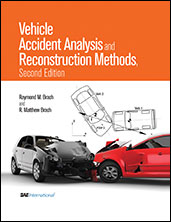Technical Paper
Comparison of Tire Friction Test Methodologies Used in Accident Reconstruction
1998-02-23
980367
Many accident reconstructions rely on the use of friction factors for the analysis of vehicle speeds. Measurement of the friction factor, or coefficient of friction, at the accident site is usually an important step in achieving a more accurate estimate of the friction factor at the time of the accident. Over the years several on site test methodologies have emerged within the accident reconstruction community. However, little has been published which compares the data and results from the different methods. This paper presents a comparison of some methodologies. A g-analyst1 accelerometer, a VC•20002 accelerometer, and a bumper chalk gun3/radar gun4 are compared for locked wheel friction values under different speed and road surface conditions. Data from the two on board systems are recorded simultaneously. Measurements are made for several stops at each of the speeds and two road surface conditions.

